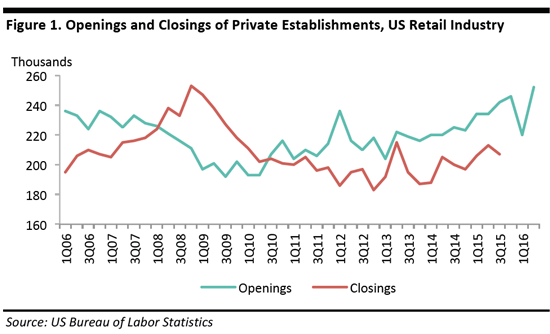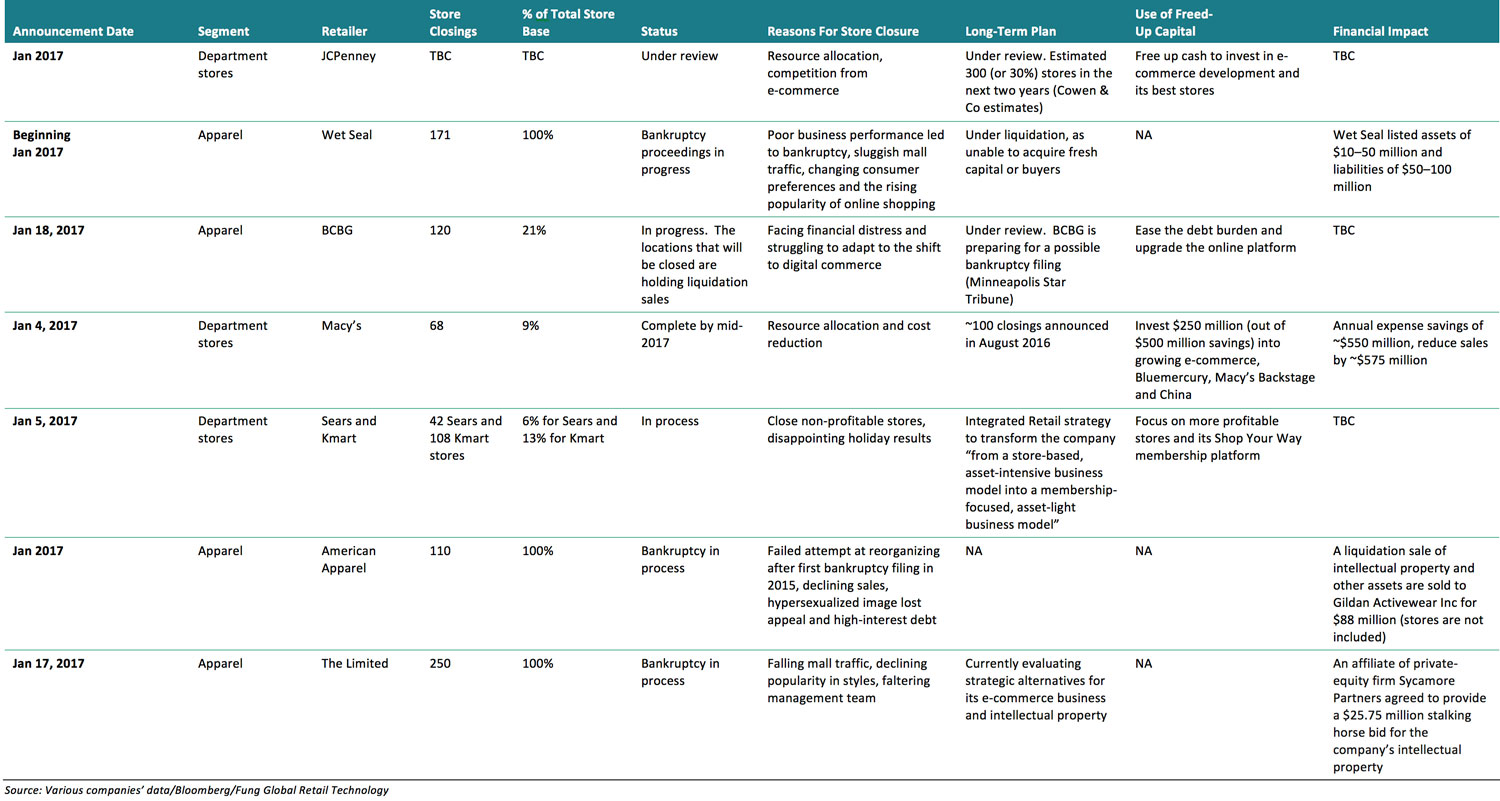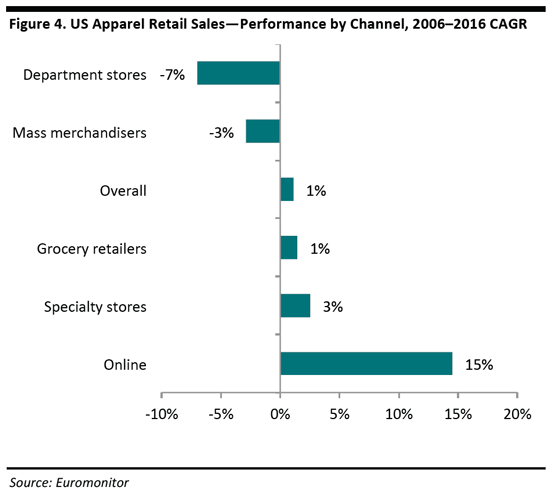
Deep Dive: US Retail—Store Closure and Management Change Tracker

KEY POINTS
- Among the major US retailers that we track, so far this year, eight have announced store closures and another six have announced management changes.
- Store closure announcements are concentrated among the department stores and specialty retailers. Those facing bankruptcy proceedings—Wet Seal, American Apparel and The Limited—plan to close their entire store network. Macy’s plans to close 9% of its total store base, Sears 6%, Kmart 13%, BCBG 21%. JCPenney has plans to cut stores in the near future.
- Management changes: Since the start of 2017, six major retailers have announced management changes, including Ralph Lauren, Tiffany & Co., Abercrombie & Fitch, Barneys, Givenchy and Coach.
- The shared rationale behind the store closures include reconfiguring the store network due to the shift to online shopping, stemming losses from unprofitable stores and reallocating resources to focus areas. Management changes announced were justified by disappointing financial performance (Tiffany & Co.), conflicting views with founders (Ralph Lauren) and planned succession (Barneys).
Executive Summary
Since the start of 2017, several major US retailers have announced store closures, bankruptcies and management changes.
In this regular update report, we track major announcements from retailers, such as store closures, bankruptcies and management changes, which we believe could provide insights into the overall health of the retail industry.
Summary of Major Announcements
- Store closures: Eight major retailers have announced store closure plans since the start of 2017. Macy’s is closing 9% of its total store base, Sears 6%, Kmart 13% and BCBG 21%. JCPenney have plans to cut stores in the near future. Wet Seal, American Apparel and The Limited are closing their entire store network.
- Bankruptcies: Wet Seal, American Apparel and The Limited are facing bankruptcy proceedings.
- Management changes: Since the start of 2017, six major retailers have announced management changes, including Ralph Lauren, Tiffany & Co., Abercrombie & Fitch, Barneys, Givenchy and Coach.
Conclusions Drawn from our Proprietary Database
- Store closures: Most of the retailers that are closing stores fall within the department store and specialty retail category. The shared rationale behind the decisions to close the stores are primarily: 1) to reconfigure the store network due to the shift to online shopping; 2) to stem losses from unprofitable stores; and 3) to reallocate resources to focus areas.
- Management changes: These changes are concentrated at the luxury and specialty retailers. The rationale behind the management changes includes disappointing financial performance (Tiffany), conflicting views with founders (Ralph Lauren) and planned succession (Barneys).
We will continue to monitor the retail industry for major announcements and provide timely updates for our readers.

Table 1: YTD 2017 Announced Store Closures
 Table 2: YTD 2017 Announced Management Changes
Table 2: YTD 2017 Announced Management Changes
Store Closings
![]() JCPenney
JCPenney
JCPenney announced that it is considering closing stores in 2017. However, the exact numbers are yet to be confirmed, according to CEO Marvin Ellison.
- Reason for store closings: A resource allocation decision. JCPenney will downsize certain locations that no longer “meet brand standards.” The announcement is a reversal from the company’s past strategy of avoiding mass stores closures in order to minimize the impact from e-commerce.
- Forecast: It is estimated JCPenney will close down more than 300, or 30% of its stores, in the next two years, according to estimates from Cowen and Company, a financial service and research firm.
- Capital deployment: Capital that is freed from store closings will be deployed into e-commerce investment and more productive stores.

![]() Macy’s
Macy’s
Macy’s announced on January 4, 2017, that it will close 68 stores, or 9% of its total store base, by mid-2017. This round of store closings is part of the company’s plan to close 100 stores over the next few years, announced in August 2016.
- Reason for store closings: Resource allocation and cost reduction due to the continuing structural shift to online shopping. According to CEO Terry Lundgren, Macy’s will “close locations that are unproductive or are no longer robust shopping destinations due to changes in the local retail shopping landscape, as well as monetizing locations with highly valued real estate.”
- Forecast: Macy’s estimates the closures will generate savings of $550 million beginning in 2017, reduce this year’s sales by $575 million and trim 3,900 off headcount.
- Capital deployment: Capital that is freed up from the store closures will be further invested in omnichannel capabilities, customer analytics and marketing strategies. Macy’s will open new stores in Abu Dhabi and Kuwait, and expand Macy’s Backstage and Bluemercury.
 Sears and Kmart
Sears and Kmart
Sears announced on January 5, 2017, that it will close 150 stores, comprising 108 Kmart stores and 42 Sears Outlets. The announcement came on the same day Sears announced the sale of Craftsman tool brand to Stanley Black & Decker.
- Reason for store closings: To stem losses: the 150 stores suffered an adjusted EBITDA loss of US$60 million. The store closure announcement came after the company reported a 12%–13% decline in same-store sales growth (SSSG) in the first two months of 4Q16.
- Forecast: Credit rating firm Fitch Ratings forecasts that Sears is in danger of default in 2017.
- Capital deployment: The company will focus on more profitable stores and its Shop Your Way membership platform. Management will execute its Integrated Retail strategy and transform the company “from a store-based, asset-intensive business model into a membership-focused, asset-light business model.

![]() BCBG
BCBG
BCBG was looking to close stores and restructure, as the company copes with a heavy debt burden and an industry shift to online shopping, according to Bloomberg news reported on January 18, 2017.
- Reason for store closings: The potential plan for store closures is likely due to financial distress. BCBG is preparing for a possible bankruptcy filing as it faced challenges including a cash crunch and debt pressure, according to Minneapolis Star Tribune. The company has hired AlixPartners LP to help restructure its debt load. The retailer has also been adapting to the shift to online shopping by closing stores and building its online platform.
- Forecast: The company is reported by Star Tribune to close about 120 stores globally, mostly in the US. However, no official announcement has been made for store closure plans. The brand operates more than 570 boutiques worldwide, including more than 175 in the US.
- Capital Deployment: The capital freed will likely be used to ease the company’s debt burden and invest in upgrades for its online platform.
![]() Wet Seal
Wet Seal
Wet Seal announced in early January 2017, that it will be closing all its 171 stores. The retailer also filed for bankruptcy in early February.
- Reason for store closings: Declining traffic, changing customer preference and increasing popularity of online shopping are the major reasons leading to Wet Seal’s bankruptcy proceeding.
- Bankruptcy: Two liquidators have been appointed to oversee the liquidation process. An attempt to acquire fresh capital or a buyer has failed, as reported by the Wall Street Journal. Wet Seal had previously filed for bankruptcy in 2015, and subsequently was bought by private-equity firm Versa Capital Management LLC for $7.5 million in cash at the time.
- Financial condition: Wet Seal reported listed assets of $10–50 million and liabilities of $50–100 million.
![]() American Apparel
American Apparel
American Apparel has been undergoing bankruptcy proceedings. It has agreed to sell its intellectual property and other assets, which exclude the 110 stores, to Gildan Activewear Inc for $88 million under a bankruptcy auction.
- Reason for store closings: American Apparel’s bankruptcy declaration is primarily due to declining sales and the brand’s failure to reposition itself in the face of changing consumer tastes. The brand’s hypersexualized image has lost its appeal with consumers. American Apparel previously filed for bankruptcy in October 2015. It suffered from the high-interest debt accumulated during the tenure of Dov Charney, the former CEO until 2015.
- Bankruptcy sale: American Apparel has agreed to selling $88 million of intellectual property and other assets, excluding its 110 stores, to Gildan Activewear Inc. Some of the stores will remain open for another three months under a 100-day license with Gildan. It is unclear what will happen to the stores once the license expires. Gildan does not have any intention to acquire American Apparel’s stores.
![]() The Limited
The Limited
The Limited announced in the first week of January 2017, that it was in the process of closing 250 stores. It subsequently filed for bankruptcy on January 17, 2017, and has agreed to a stalking horse bid for its intellectual property and some other assets.
- Reason for store closings: Slowing mall traffic, declining popularity of the brand’s offerings and the rise of e-commerce sales have contributed to its bankruptcy. The Limited experienced the departure of two CEOs in two months—Diane Ellis left in October 2016 and her replacement also left in December 2016.
- Bankruptcy sale: An affiliate of private-equity firm Sycamore Partners has announced a $25.75 million stalking horse bid for the company’s intellectual property, which includes its trademarks, website address and social media accounts.
- Long-term planning: The Limited is currently evaluating strategic alternatives for its e-commerce business and intellectual property, in addition to considering a sale to a potential buyer.

Management Changes
 Ralph Lauren
Ralph Lauren
Ralph Lauren announced on February 2, 2017, that Stefan Larsson, President and CEO, will leave the company effective from May 1, 2017.
- Reason for departure: Outgoing CEO Larsson had “different views on how to evolve the creative and consumer-facing parts of the business” with Ralph Lauren, the company’s Executive Chairman and Chief Creative Officer.
- Replacement plan: Ralph Lauren has commenced a search for a new CEO. In the interim, CFO Jane Neilsen will lead the company.
- Profile of outgoing CEO: Larsson has served as the President and CEO of Ralph Lauren since November 2015 and reported to Executive Chairman Ralph Lauren. During his tenure, he cut jobs, closed stores, improved the online experience and streamlined the supply chain. Prior to joining Ralph Lauren, Larsson’s background was in budget apparel: he served as the Global President of Old Navy and H&M.
- Strategic changes accompanying the management change: The new CEO is expected to execute the Way Forward Plan, announced in June 2016, to drive future growth through refocusing the brand, evolving the product and marketing. The new CEO will need to reverse the challenges of discounting, overreliance on department stores and an aging customer base, which the brand has faced in recent years.

![]() Tiffany & Co.
Tiffany & Co.
Tiffany & Co. announced on February 5, 2017 that CEO Frederic Cumenal would step down, effective immediately. The company replaced design director Francesca Amfitheatrof with Reed Krakoff as Chief Artistic Director in January, effective February 2017, and replaced Ralph Nicoletti with Mark Erceg as CFO in October 2016.
- Reason for departure: The board is disappointed by recent financial results and weak holiday sales.
- Replacement plan: Tiffany has commenced a search for a new CEO. Chairman and previous CEO Michael Kowalski will serve as interim CEO.
- Profile of outgoing CEO: Outgoing CEO Cumenal assumed the position of CEO in April 2015 and held senior roles when he oversaw the company’s global expansion and development of new collections. Prior to joining Tiffany in 2011, Cumenal held senior leadership positions at LVMH Group, including as President and CEO of Moet & Chandon.
- Strategic changes accompanying the management change: The company is committed to its core business strategies, which include enhancing customer experience and marketing effectiveness, increasing the rate of new product offering and optimizing the store network and costs. Management also affirmed its guidance for fiscal year 2016. Tiffany faced challenges on the back of a strong US dollar and a decline in tourism spending across all regions.
![]() Abercrombie & Fitch
Abercrombie & Fitch
Abercrombie & Fitch announced on January 30, 2017, the appointment of Will A. Smith as Chief Marketing Officer. On February 1, the company made another announcement that the current President and Chief Merchandising Officer, Fran Horowitz, had been promoted to CEO. Joanne Crevoiserat, Executive Vice President and CFO, was also promoted to COO while continuing in her current roles. All appointments are effective immediately.
- Reasons for appointments: Smith’s introduction aims to strengthen Abercrombie’s connection with the customer and enhance the power and clarity of the brand identities.
The promotion of Horowitz ends a two-year period when the company was run by an Office of the Chairman—which included Horowitz and Executive Chairman Arthur Martinez—which was established after the departure of then CEO Christos Angelides.
- Profile of new management: Smith has served in senior marketing roles at Caleres Inc. (formerly known as Brown Shoe Company) for the past nine years, assuming the position of Chief Marketing Officer for Famous Footwear/Brown Group Retail in 2013. During his tenure, the company achieved rapid e-commerce traffic gains. He led the parent company’s corporate rebranding initiative and revitalized a customer-loyalty program that now delivers nearly three-quarters of the organization’s total annual revenue. Prior to joining the Famous Footwear/Brown Group Retail, Smith worked for iconic companies such as Kraft, Atlantic Records and Liz Claiborne, in various brand and marketing roles.
Horowitz, has served as President and Chief Merchandising Officer of Abercrombie & Fitch Co., where she showed strong leadership in the turnaround of Hollister. Prior to joining Abercrombie in 2014, Horowitz held various positions at Ann Taylor, Loft, Express, Bloomingdale’s, Bergdorf Goodman, Bonwit Teller and Saks Fifth Avenue.
Crevoiserat, has been Executive Vice President and CFO of Abercrombie & Fitch since May 2014, and a member of the Office of the Chairman since October 2015. Prior to joining Abercrombie, she served in a number of senior management roles at Kohl’s Inc., including Executive VP of Finance and Executive VP of Merchandise Planning and Allocation, and held senior finance positions with Wal-Mart Stores and May Department Stores.
- Strategic changes accompanying the management change: The company is dedicated to provide a compelling, customer-focused shopping experience. While these appointments reflect a structural management change that results in the dissolution of the Office of the Chairman, which had been leading the company since the departure of long-time CEO Mike Jeffries in December 2014, they do not affect the company’s core strategies. Along with the management appointments, the retailer also announced that it would be cutting 150 jobs at its company headquarters as part of cost-reduction initiatives.
 Barneys
Barneys
On February 2, Barneys named Daniella Vitale as its new CEO, replacing her predecessor Mark Lee, who will take on a new role as Executive Chairman.
- Reason for appointment: The succession plan for Vitale to become CEO in 2017 was formally set out in 2012.
- Profile of new management: A former head of Gucci, Mark Lee joined Barneys as CEO in 2010. Lee recruited Vitale, his longtime Gucci colleague, when he joined Barneys. Vitale was elevated to the top job from her position as COO overseeing all of women’s merchandising, business development, digital strategy and store operations. She previously worked at Gucci, Giorgio Armani and Ferragamo USA.
- Strategic changes accompanying the management change: The management turnover is a natural and expected process. Lee named Vitale as his “heir apparent”, and had been mentoring her over the past six years. The controlling holder of the company, hedge-fund mogul Richard Perry, also expressed strong confidence in Vitale’s capacity in day-to-day management. Lee will continue to support Perry at the board level.
![]() Givenchy
Givenchy
Givenchy, owned by LVMH Moët Hennessy Louis Vuitton, announced on February 2, 2017, that Creative Director Riccardo Tisci would be leaving after 12 years with the brand.
- Reason for departure: Tisci’s voluntary resignation to focus on his “personal interests and passions” was effective January 31, 2017. There are unconfirmed speculations that he will join Versace.
- Replacement plan: Givenchy stated that a successor will be announced soon.
- Profile of outgoing Creative Director: According to the New York Times, Tisci transformed Givenchy into one of LVMH’s most successful brands. He revived the brand and was an early adopter of social media. Since Tisci joined Givenchy in 2005, the number of employees more than tripled and stores increased from 7 to 72.
- Strategic changes accompanying the management change: To be confirmed.
![]() Coach
Coach
Coach announced on January 4, 2017, that it had appointed Kevin Wills as its CFO, effective no later than March 2017.
- Reason for hiring: Wills was hired to replace previous CFO Jane Nielsen, who departed Coach for Ralph Lauren in August 2016. Wills will take over from interim CFO Andrea Resnick
- Profile of incoming CFO: Wills has almost 30 years of experience in retail and finance. He joins Coach from AlixPartners LLP, a global business advisory firm, where he served as Managing Director and CFO since March 2014, and specialized in corporate turnaround, capital restructuring and M&As. Prior to AlixPartners, Wills served for 16 years in various senior leadership positions at Saks Fifth Avenue.
- Strategic changes accompanying the management change: To be confirmed. Coach’s undertakings since CEO Victor Luis took over in 2014 include: 1) attempting to elevate brand perception; 2) appealing to more fashion-engaged consumers; 3) launching a broader high-end collection; and 4) seeking acquisitions to broaden the portfolio. The company saw profit growth for fiscal year 2016, a reversal from the declining sales and stores closures of the past three years.

